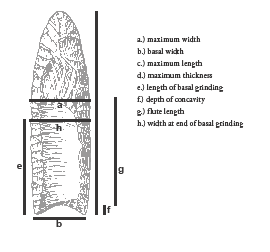SPECIMEN SUGGESTED TYPE NAME MONTANA PALEOINDIAN POINT DATA
SPECIMEN – FARM PARTNERSHIP AGREEMENT MATERIAL4H GEOLOGY SPECIMEN LABELS (SUGGESTED FORMAT) ROCK IDENTIFICATION CARDS
4I SPECIMEN LETTERS FOR DISCIPLINARY BOARDS DISCIPLINARY BOARD REPORT
57 PROJECT NAME MICROBIOLOGY SPECIMEN LABELING INCIDENTS INSTITUTION THE
7 WAMTS PRESERVATION AND LODGEMENT OF TERRESTRIAL INVERTEBRATE SPECIMENS
A TABLE OF SPECIMENS REQUIREMENTS FOR COMMONLY REQUESTED TESTS
Specimen #_______ Type Name______________
Specimen #_______ Suggested Type Name_________________
Montana Paleoindian Point Data Form
Owner:____________________________ Address:__________________________________________
Phone:__________________________ Email: __________________________
Public Access Constraints: ______________________________________________________________
Recorder’s Name and Address:___________________________________________________________
Address: __________________________________Phone: ________________Email: ______________
Image Number or Identification:__________________________________________________________
Location of Find:___________________________ Location Ownership: ________________________
Nearest Water Source:_______________________ River Drainage:_____________________________
Slope of Find Location:______________________ Method of Recovery:_________________________
References:_______________________________ USGS quad sheet: ___________________________
Attributes
Measurements (English or metric)
Max. Width: ____________________________
Basal Width: ____________________________
Length of Basal Grinding: _________________
Width at end of Basal Grinding: ____________
Length (Actual): _________________________
Length (Complete): ______________________
Max. Thickness: _________________________
Depth of Basal Concavity: _________________
Obverse face–
Basal Thinning/Flute #1 L ______W _________
Basal Thinning/Flute #2 L ______W _________
Basal Thinning/Flute #3 L ______W _________
Basal Thinning/Flute #4 L ______W _________
Reverse face–
Basal Thinning/Flute #1 L ______W _________
Basal Thinning/Flute #2 L ______W _________
Basal Thinning/Flute #3 L ______W _________
Basal/Thinning/Flute #4 L ______W _________
General Attributes
Material: ________________________________
Color: __________________________________
Patination: ______________________________
Edge Shape: _____________________________
Edge Retouch: ___________________________ |___________|____________|
Basal Grinding: __________________________ 0 1 2 inches
T
SKETCH
POINT ABOVE
Manufacturing Notes: _________________________________________________________________
Reworking Notes: ____________________________________________________________________
Special Attributes: ____________________________________________________________________
Attached Sketches/Tracings/Digital Images/Photocopies of Point: ____________ pages
Montana Paleoindian Point Recording Project Attribute Key
For the following fields, record the following information:
L ocation
of Find—Locate
as exactly as possible, using legal description and/or UTM
designation. Surface-collected points should be located to within
1/4 mile of actual location. Archaeologically-recovered points
should be located within site both horizontally and to depth below
surface, with publication references, and artifact disposition.
ocation
of Find—Locate
as exactly as possible, using legal description and/or UTM
designation. Surface-collected points should be located to within
1/4 mile of actual location. Archaeologically-recovered points
should be located within site both horizontally and to depth below
surface, with publication references, and artifact disposition.
Nearest Water Source—Name the nearest water source and distance to that source.
River Drainage—Name the larger river drainage system where the site is located
Slope of Find Location—Describe which way the slope of the find location faces
Method of Recovery—Examples include “Surface collected in plowed field, Surface collected on eroded bank, Shovel-test recovery, Archaeological excavation.”
Material—Record raw material, preferably with a bedrock locality or even quarry.
Color—Give Munsell® Soil Color Chart hue, value, and chroma where possible.
Patination—Note whether the point is patinated or not. If there is evidence of post-discovery chipping, attempt to gauge thickness of patination.
Edge Shape—Note the shape of the working edges of the point (for example: straight/excurvate/ incurvate)
Edge Retouch—Describe the reworking of the point’s edges. Note pressure flaking/resharpening.
Lateral and Proximal Edge Basal Grinding—Note presence/absence, describe as “heavy or light.”
Basal Thinning or Fluting Techniques——Describe any special basal thinning or fluting features. For example, note if thinning or flute scars do not terminate near the end of the point, if most of the fluting scar has been removed by subsequent flaking.
Reworking Notes—Describe any evidence of the artifact’s reshaping that might have affected the point’s use.
Special Attributes—Describe any special attributes of interest (e.g., burn pot lidding, shaft mastic adhering, association with animal bones).
Other Notes
____________________________________________________________________________________________________________________________________________________________________________________________________________________________________________________________________________________________________________________________________________________________________________________________________________________________________
C://Montana Point Recording Form 2009.doc Page
ADDING SPECIMENS TO A SPECIMEN LIST PURPOSE SPECIMEN LISTS
ANNEX 1 COMPLETE LIST OF EXAMINED SPECIMENS CUBA ORIENTE
ANNEX 6 SPECIMEN LETTER TO PARENTS OF CHILDREN UNABLE
Tags: montana paleoindian, pages montana, paleoindian, suggested, specimen, montana, point
- DRUŠTVO ZA LINIJSKI POMORSKI PRIJEVOZ PUTNIKA I TERETA RIJEKA
- CALIFORNIA ASSOCIATION OF CLERKS AND ELECTION OFFICIALS LEGISLATIVE COMMITTEE
- PERSPECTIVAS ESTRATÉGICAS DE DESARROLLO SUSTENTABLE PARA LAS MONTAÑAS ANDINAS
- ZAKRES IV ZAŁĄCZNIK NR 1B WARUNKI KONIECZNE DO SPEŁNIENIA
- 2 TOČKA DNEVNEGA REDA 16 SEJE OBČINSKEGA SVETA OBČINE
- ONDOKUZ MAYIS ÜNİVERSİTESİ SOSYAL VE BEŞERİ BİLİMLER GÖNÜLLÜ KATILIM
- SECOND HIGHLEVEL MEETING ON THE OEASERKXXIX SPECIAL SECURITY CONCERNS
- 1 NUMEROS CUÁNTICOS NÚMEROS CUÁNTICOS 1º UN ELECTRÓN ESTÁ
- AEAT DIT SG DE APLICACIONES INFORMATIVAS 2015 SERVICIOS DE
- FİZİK ANABİLİM DALI DERSIN ADI İSTATISTIK FIZIK VE TERMODINAMIK
- PHYSICAL FACTORS STRIPS SOLID FOUNDATIONS ARE REQUIRED FOR THE
- PRESS RELEASE MEDIA CONTACTS SOPHIA DILBERAKIS SD COMMUNICATIONS (312)
- RJEŠENJE O ODOBRAVANJU OCU MAJCI DJETETA SA TEŽIM
- PCTR17 (PROPOSALS BY FRANCE) PAGE 3 WIPO E PCTR17
- {0ELIGIBILITY FORM FOR TANF FUNDED SERVICES}0{FORMULARIO DE ELEGIBILIDAD PARA
- AVIS DE MANIFESTATION D’INTERET N°2012006AMIFASO BAARA ETUDES ARCHITECTURALES ET
- UNEPCBDICNPREC2 PÁGINA 0 CBD DISTR GENERAL UNEPCBDICNPREC28 26 DE
- JUNTA GENERAL DE SOCIOS DE LA SGR DE LA
- LEARNING OUTCOMES FOR ORTHOPAEDIC POST THE MIXTURE OF INPATIENT
- ALTERNATE TESTING PASS FORM STUDENT SUCCESS CENTER – 117
- PÁGINA 5 DE 5 FERIA TURISMO PERÚ ¡VIAJAR POR
- GUIDELINES FOR TRANSFERRING FUNDS OR STOCK TO LVHN
- AN ADMINISTRATOR’S GUIDE TO USING EMARC PLUS V431
- HALOWY KALENDARZ TURNIEJOWY GRAND PRIX LUBELSZCZYZNY PACIFIC KIDS CUP
- 8 TJEDAN BOTANIČKIH VRTOVA ARBORETUMA I BOTANIČKIH ZBIRKI 14
- CONTRADICCIÓN DE TESIS 3102010 CONTRADICCIÓN DE TESIS 3102010 ENTRE
- PEDERSBORGS BEBOERMAPPE [UNDEROVERSKRIFT] UDGIVET AF [NAVN(E)] [MÅNED] [ÅRSTAL] INDHOLD
- 3052000 2(2) ANVÄNDNING AV BROKERS VID FÖRMEDLING OCH MARKNADSFÖRING
- L A MORT I EL PROCÉS DE DOL EN
- ASSOCIACIO CULTURAL “CARDONA I VIVES” WWWCARDONAVIVESCOM INFOCARDONAVIVESCOM
PRINCIPIO DEL FORMULARIO NOMBRE LEY DE ÉTICA GUBERNAMENTAL COMENTARIOS
92 ANATOMÍA TOPOGRÁFICA CAVIDAD BUCAL ZONA IMPORTANTE Y
PLAN FOR SYKKELTILTAK I BERGEN 20022011 KOMITE FOR MILJØ
ORIGINALLY PUBLISHED AS “DIE LEBEN DER ELENA SILBER” ©
 ŁÓDŹ DNIA KARTA OCENY DZIAŁALNOŚCI NAUCZYCIELA AKADEMICKIEGO W
ŁÓDŹ DNIA KARTA OCENY DZIAŁALNOŚCI NAUCZYCIELA AKADEMICKIEGO W UNIVERSIDAD NACIONAL DE LA PLATA ACREDITACIÓN DE PROYECTOS DE
UNIVERSIDAD NACIONAL DE LA PLATA ACREDITACIÓN DE PROYECTOS DE 34 OSZTÁLY 1 FELADATLAP TITOK ANGOL VERSENY KÓD
34 OSZTÁLY 1 FELADATLAP TITOK ANGOL VERSENY KÓD WWWHEALTHANDENVIRONMENTORG INFOHEALTHANDENVIRONMENTORG VALLOMBROSA TRADUCCIÓN GRACIELA CARBONETTO DECLARACION DE CONSENSO
WWWHEALTHANDENVIRONMENTORG INFOHEALTHANDENVIRONMENTORG VALLOMBROSA TRADUCCIÓN GRACIELA CARBONETTO DECLARACION DE CONSENSONOTICE TO TERMINATED ACCOUNTANT OR ENROLLED ACTUARY I AS
 1 O NAMA CENTAR ZA AUTOMATSKI NADZOR NAD CESTOVNIM
1 O NAMA CENTAR ZA AUTOMATSKI NADZOR NAD CESTOVNIM ESCUELAS PROMOTORAS DE SALUD ANEXO II CUESTIONARIO DE ACREDITACIÓN
ESCUELAS PROMOTORAS DE SALUD ANEXO II CUESTIONARIO DE ACREDITACIÓN 3209 NEIGHBOURHOOD RESIDENTIAL ZONE 22082013 VC104 SHOWN ON THE
3209 NEIGHBOURHOOD RESIDENTIAL ZONE 22082013 VC104 SHOWN ON THE VICERRECTORADO DE PROFESORADO E INVESTIGACIÓN INFORME DEL DIRECTOR DE
VICERRECTORADO DE PROFESORADO E INVESTIGACIÓN INFORME DEL DIRECTOR DESHOW JUMPING RESULTS SUNDAY DECEMBER 30 2007 CSI5W MECHELEN
 SEMINARIOS DNINIFNIU USUARIO ( DATOS OBLIGATORIOS) 1 DATOS IDENTIFICATIVOS
SEMINARIOS DNINIFNIU USUARIO ( DATOS OBLIGATORIOS) 1 DATOS IDENTIFICATIVOSARCHIVADOR VERTICAL MATERIAL DE M TERESA PORCILE SANTISO
 ZAGREB 21 OŽUJKA 2021 POŠTOVANI GOSPODIN DR SC TOMISLAV
ZAGREB 21 OŽUJKA 2021 POŠTOVANI GOSPODIN DR SC TOMISLAV LA TOUSSAINT QU’ESTCE QU’UN SAINT ? QUE FÊTENT LES
LA TOUSSAINT QU’ESTCE QU’UN SAINT ? QUE FÊTENT LES LØDINGEN KOMMUNE ENHET HELSE OG OMSORG FOR OPPHOLD I
LØDINGEN KOMMUNE ENHET HELSE OG OMSORG FOR OPPHOLD I 3 OBĚHOVÁ SOUSTAVA VNITŘNÍ PROSTŘEDNÍ ORGANISMU TVOŘÍ KREV
3 OBĚHOVÁ SOUSTAVA VNITŘNÍ PROSTŘEDNÍ ORGANISMU TVOŘÍ KREV